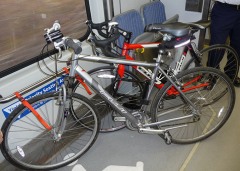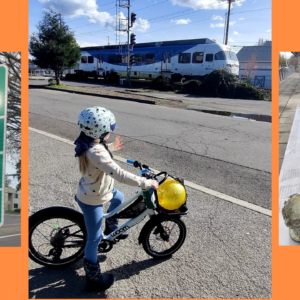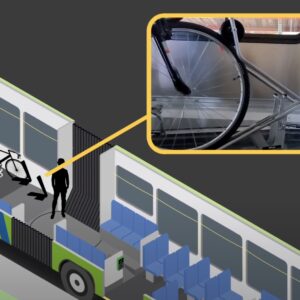
area to increase bike capacity.
(Photos: Jim “K’Tesh” Parsons)
When TriMet’s WES commuter rail line between Wilsonville and Beaverton opened back in January, many bike commuters were concerned about the lack of onboard bike capacity. WES had only two bike hooks per car, compared to four hooks on MAX trains.
One reason for this is because WES, unlike MAX, falls under the “commuter rail” category and as such, is regulated by the Federal Railway Administration (FRA). As TriMet GM Fred Hansen clarified in a TriMet Board meeting where the topic came up in February, “there’s a different set of requirements” for how objects must be secured on commuter rail trains.

TriMet was aware of the problem and they now seem to be testing out a solution. BikePortland West Side correspondent Jim “K’tesh” Parsons noticed Tuesday that TriMet has installed straps in the wheelchair access areas. Parsons found four straps per car, bringing the total bike capacity up to six bikes (as long as the wheelchair areas are not in use).
TriMet’s website still says (in bold letters), “If both racks are occupied, you must wait for the next train,” but I have now learned updated information from TriMet’s Carolyn Young. She said this is a pilot project.
“The straps will be evaluated to determine how well this works for our riders and to test the durability of the straps,” she wrote via email. Young also wrote that, while bikes must yield the space to riders with disabilities, she doesn’t think there will be much conflict given the current number of riders on WES. “However,” she added, “if we do see more mobility devices on the trains we will need to take a new look at this.”






Thanks for reading.
BikePortland has served this community with independent community journalism since 2005. We rely on subscriptions from readers like you to survive. Your financial support is vital in keeping this valuable resource alive and well.
Please subscribe today to strengthen and expand our work.
Seems like a pretty bad design if bikes and wheelchair passengers are supposed to occupy the same spot.
I really appreciate that TriMet is trying out something creative like this to address the bike demand on WES. Velcro straps are used by CalTrain in California to secure bikes.
It’s not ideal that wheelchair passengers and bike-bringing passengers might conflict over this spot (more likely conflict is between strollers and bikes, perhaps) but we’re all nice enough to make it work, I hope!
I can see it on Oregonlive.com already: Bikers not satisfied with taking precious on street parking spaces away from tax-paying motorists now gleefully taking away wheelchair spaces from the physically disabled.
Hart, Trimet has a longstanding policy taht if the bike racks on MAX are full, bicyclists can use the priority seating area, but they have to yield to seniors and people with disabilities. I assume the same rule still applies here…
I really think Trimet should have signage on both MAX and WES to this effect.
What I don’t understand is TriMet’s inability to “get it.” Gee, one of the most bicycle friendly cities in the nation, yet they constantly fail to plan for bike storage on trains.
Their solution is to build bike parking or to have to retro fit. The majority of bike commuters need their bikes on both ends of the ride so blowing a million bucks on bike storage (as one solution) is a not worthy and failing to take these needs into consideration is just bad planning.
While I appreciate TriMet’s commitment to meet bicyclists needs, I am not sure this is the best approach.
If I understand the concept, bicyclists would need to yield the space to those using a wheelchair- at the least, this could delay boarding (I’d guess the bicyclist would need to collect their bike and get off the train if no other parking is available), and at worst, it creates potential conflict (if the bicyclist does not yield the space, does the person using the wheelchair have to advocate for the space, ask for help, get off the train or what?).
Much like parking conflicts- where drivers park in the striped area next to a handicap space blocking the ramp access needed for a person in a wheelchair to exit the van/access the walkway- I can imagine a well-intentioned bicyclist attempting to squeeze their bike in next to the wheelchair in an effort to “share” the space on the train.
People using wheelchairs already face significant structural obstacles just trying to get from point a to point b; why introduce more barriers in to the mix?
Perhaps TriMet can come up with a better solution? Perhaps remove a row of seats to accommodate wheelchairs and bikes.
TriMet really needs to understand its customer share better. They might find that they are not well serving the many cyclists who are paying fares into the system. If Caltrain and other “commuter rail” operators can serve cyclists in parts of the country where bike mode share is lower than in Portland, TriMet needs to step up and stop making excuses.
Caltrain has a ” bike car “
Hart, Trimet has a longstanding policy taht if the bike racks on MAX are full, bicyclists can use the priority seating area, but they have to yield to seniors and people with disabilities.
Since when have things like “facts” prevented the Olive.com from trying to get the mud flinging?
Take old high floor train and remove the 6 seats at each end.
In place of these install 4, possibly 5, of these type of bike racks against the outside wall surface in an angle parking setup.
It would allow a more efficient use of the space which seems to currently setup to encourage animosity against cyclists.
she doesn’t think there will be much conflict given the current number of riders on WES
Is anybody actually riding WES? Are people taking bikes along for the WES commute?
In other words, is this even a problem?
remmers (#6) – one point in which WES differs from MAX is that WES has conductors in the trains who can resolve these conflicts, unlike MAX, which only has a driver who is not physically present in the car.
One of the issues Tri-Met faces is that the system operates at or near capacity much of the day, and because of the increased footprint of bicycles, it’s difficult to accommodate them. This, in my opinion is the biggest problem with Tri-Met: as a public/private partnership, Tri-Met attempts to minimize costs at the expense of service. Their customers (riders) inherit the worst of both worlds.
There will be no lasting change at Tri-Met unless Tri-Met is made a fully public entity, and beholden to the will of the public rather than to its shareholders.
(Note: Being fully public brings its own problems, and I am not so naive to be unmindful of that fact)
Michael M. (#11) – yes, people are riding WES – it’s typically about half full during the evening commute, and both bike racks are in use about 75% of the times I’ve ridden it. If it follows the typical Tri-Met trend, it’ll be fully utilized within a year, and tri-Met will be dealing with capacity issues during the peak travel times. For WES, since it runs only during peak commuter hours, that will rapidly become capacity issues during the entire time of service.
Michael M. #11
I think you are right. From what I’ve heard the WES line is seriously underutilized. Read: not a lot of commuters are using it yet.
Its’ great that TriMet is willing to offer a good chunk of available space on the train to accommodate extra bikes.
At the same time, I don’t understand all the folks who are complaining about TriMet not serving bicyclists very well. There are not that many cities around the world where you are allowed to bring a full-sized bike on transit. To me, the glass here in Portland is more than half full.
Okay, maybe I shouldn’t rely so much on hearsay and first await the response of the experts on how much WES is really utilized.
Thanks for educating us Matt and great to hear that ridership it is trending upwards.
I can add some anecdotal evidence to the question of how much of a problem this is and how utilized the WES is on a regular basis.
I use both a bike and TriMet to get to work in the Tigard area, and for me it’s usually a decision between taking the 44 or the 12 (biking on both ends) or taking MAX from PGE to Beaverton TC and then WES to Tigard. Often I don’t risk taking the WES because I know there are potentially only 2 available bike spaces, and I would have to wait 30 minutes for the next train, whereas a bus comes every few minutes – on the off chance the rack is full.
I would agree that WES is usually about half to three quarters full, but I have been on it a couple times when it has been standing room only. It’s rarely at capacity, but I wouldn’t say it’s underutilized. On the other hand, I have been caught without a ride several times due to a lack of available bike racks. Not once have I seen the priority seating area in use.
I highly doubt that anyone would refuse to take their bike off the train if a person with a wheelchair needed to use the space – furthermore, I don’t think there’s any way the WES conductors would allow that to happen. They are very attentive and a couple of them are pretty big dudes – I doubt they’d meet much resistance from some AH that didn’t want to leave the train.
The existing racks on WES are just plain dumb.
They leave the entire mass of the bike unsupported axially to the train, so that when the train accels and decels, the bike torques around your tire and the hook, thereby tacoing your wheel. I always sit next to my bike to stabilize it because of this.
There will be no lasting change at Tri-Met unless Tri-Met is made a fully public entity, and beholden to the will of the public rather than to its shareholders.
Amen, Brother Matt!
Thanks for the info, Matt & Paul. I’ve heard very little about WES utilization, except offhand snark from a few sources that are anti-rail, which I didn’t take as objective or informed observations. The quote Jonathan attributes to Carolyn Young is the first semi-official observation I’ve seen. FWIW, Kris, I wasn’t trying to be “right” about anything, I was just asking! Sometimes a question can seem like an accusation or insinuation, especially when it’s written and not spoken, but it really was just a question. (Er, okay, technically three questions.)
Sounds like Tri-Met may have a problem on its hands down the road, so I guess it’s good they’re thinking about it now.